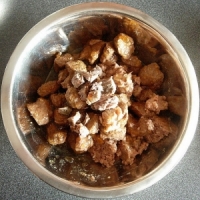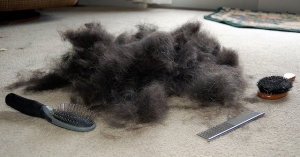Coat Changes in the Adult Havanese
Surviving adolescent coat-change does not mean that you are done with coat changes with your Havanese. The coat will continue to develop throughout your dog's life although changes through adulthood tend to be more subtle. For the most part, other than normal coat maturation, adult coat changes are caused by stresses to the system. Stress in any form, whether internal, external or emotional, can alter the normal phases of hair growth and rest periods. Contributing factors are genetics, nutrition, general health, stress, grooming care, climate and age. Furthermore, the intact female has an extra dynamic with hormonal fluctuations throughout her life having significant impact on her coat.
Genetics: Individual breedlines will have dogs with faster or slower developing coats, less or more undercoat and varying texture. Whether a dog is destined to have a heavy coat, light coat or somewhere in between largely rests with the genes that have been inherited. The coat will continue to develop for two to four years as your dog matures, growing in both length and fullness until it achieves the waving silken mantle the Havanese breed is known for.
 Nutrition: Any living being that endures
insufficient nutrition, whether from lack of sustenance or from low-quality food, can exhibit visible signs of poor nutrition.
The coat suffers along with the body. Improper diet and poor nutrition can lead to a coat that is dull, oily or dry, coarse in texture,
sparse or patchy with excessive or unusual shedding. Proper nutrients are vital factors in the development and maintenance of healthy skin and coat.
Nutrition: Any living being that endures
insufficient nutrition, whether from lack of sustenance or from low-quality food, can exhibit visible signs of poor nutrition.
The coat suffers along with the body. Improper diet and poor nutrition can lead to a coat that is dull, oily or dry, coarse in texture,
sparse or patchy with excessive or unusual shedding. Proper nutrients are vital factors in the development and maintenance of healthy skin and coat.
General health: Coat condition is a good indicator of general health. A healthy coat is shiny and supple; the skin underneath should be clear and smooth. A coat that is dry, brittle and excessively shedding along with skin that is itchy, flaky or greasy may signal an underlying health issue. Issues can be mild or severe, from itchy ear mites to devastating sebaceous adenitis. Once disease, parasites, and infections are brought under control, existing coat issues can dramatically resolve. Any unexpected change in coat condition warrants a veterinary check-up.
Stress: Physical or emotional stress will certainly affect your dog's appearance. The more prolonged or severe the stress is, the greater the impact will be. Hair texture and luster are particularly affected, and, even low-shedding breeds like the Havanese may shed excessively when under stress. Illness (acute or chronic) can have similar impact. Anesthetics used in surgery may provoke a brief shedding cycle and loss of undercoat.

Grooming care: While genetics gives the starting point and general health and nutrition influence your pets' coat from the inside, the care you give to the outside also matters greatly. Frequent and regular grooming will help keep your dog's coat in optimum condition. Grooming skills, or lack thereof, will affect appearance. A heavy hand can damage the coat, as can poor quality or improper grooming products. Keep your pet's coat clean and tangle free and don't hesitate to ask for help if you are having trouble keeping your Havanese well groomed.

Climate: Heat and humidity in warmer months can affect texture and appearance of the coat, similar to the fizziness that occurs in human hair in high humidity. Certain colours can get a faded or bleached appearance in summer; sunburned coats may have a reddish tint. There are commercial grooming products available that contain sunscreen to help protect the coat from sun damage. Although not overly common, some dogs do suffer from environmental allergies to grasses and pollens, which can lead to itching, scratching and coat chewing. In colder months, dry conditions and lack of humidity can lead to skin irritation and brittle coat. Careful selection of grooming products can help somewhat with many of these.
Hormones: When a bitch is in estrus, as well as throughout pregnancy and nursing, fluctuating hormones can impact coat condition, affecting both quantity and quality. Most bitches blow their undercoat after a season. In an un-bred female, undercoat shedding generally happens about three months after the heat cycle. Some bitches drop only part of their undercoat and others drop the whole of it. Hormonal shedding is usually restricted to the undercoat; shedding of the topcoat is much less common. Extra brushing may stimulate the follicles to let go the loose hair and promote faster regrowth. Daily grooming will help remove dead undercoat and prevent matting as well as limit loose hair around the house and on the furniture. When there is little to no undercoat to fluff out the topcoat, the bitch can look naked and skinny even though she is not. The coat loss is temporary; the undercoat grows back quite quickly and in a month or so, she will be back to her beautiful self.
A bitch that has been bred may show even more changes. In pregnancy, it is not unusual for the coat to become either softer or coarser.
As whelping approaches, a bitch will begin to lose the fur on her belly as a normal part of the maternal cycle. It is quite normal for a
bitch to blow her undercoat about four to eight weeks after whelping. Some hair loss during lactation may also happen. An assault to the
topcoat comes from the puppies themselves as they roughhouse; climb on and over their dam and chew on her fur. The good news is that the
coat will grow back; the bad news is that another few months pass and the cycle starts all over again. A bitch will continue to have
seasons throughout her entire life unless/until she is spayed, although in some cases, seasons may become less frequent as she gets older.
Age: Last but certainly not least of adult coat changes, advancing age can play a factor in the quality and appearance of the coat, which we will explore in the next article.